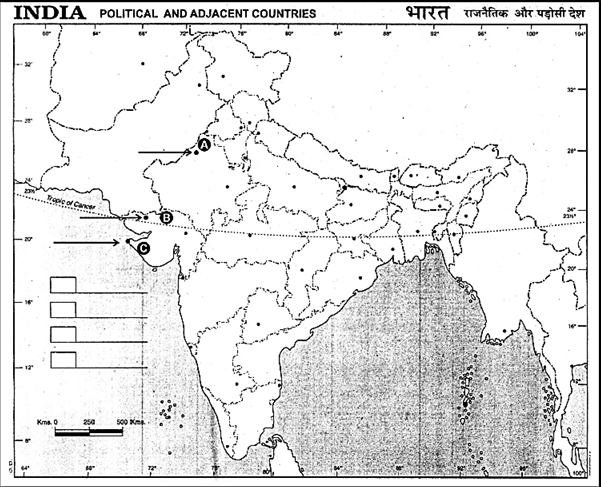 Short Answer Type
Short Answer TypeThe burials in Harappan sites reveal the economic and social differences amongst the people living within a particular culture. Give two evidences in support of your answer.
What evidences have been put forward to explain the collapse of the Harappan Civilization ?
On the given outline political map of India locate and label the following with appropriate symbols:
(a) Ajmer, a territory under Mughals.
(b) Gwalior, a centre of the Revolt of 1857.
On the same map three places related to the mature Harappan sites has been marked as A, B, C. Identify them and write their names correctly on the lines drawn near them.
Why were many Zamindaris auctioned after the Permanent Settlement in Bengal ? Give two reasons.
‘Kabir was and is to the present a source of inspiration for those who questioned entrenched social institutions and ideas in their search for divine.’ Explain.
“The nobility was recruited consciously by the Mughal rulers from diverse ethnic and religious groups.” Justify.
(i) The nobility was recruited from diverse ethnic and religious groups.
(ii) Nobility was composite one comprising Iranis, Afghans, Rajputs, Shaikhzdas, Deccanis on the basis of their service loyalty to the king.
(iii) This ensured that no faction was large enough to challenge the authority of the state.
(iv) The officer corps of the Mughals was described as a bouquet of flowers (guldasta) held together by loyalty to the emperor.
(v) People from many races (Arabs, Iranians, Turks, Tajiks, Kurds, Tatars, Russians, Abyssinians, people from Egypt, Syria, Iraq,Arabia, Iran, Khurasan, Turan) –have sought refuge in the imperial court.
(vi) Two ruling groups of Indian origin entered the imperial service- Rajputs and the Indian Muslims.
(vii) Examples- Raja Todar Mal, who belonged to the Khatri caste was Akbar’s finance minister.
(viii) Iranians gained high offices under Jahangir, whose politically influential queen, Nur Jahan (was an Iranian).
(ix) Aurangzeb appointed Rajputs to high positions, and under him the Marathas accounted for a sizeable number within the body of officers.
(ANY FOUR)
Examine the circumstances that led to the passing of ‘Limitation Laws’ by the British in 1859.
